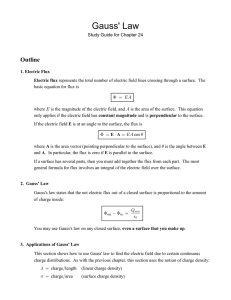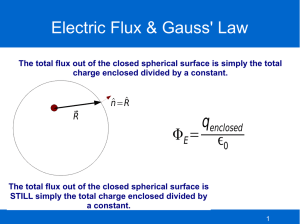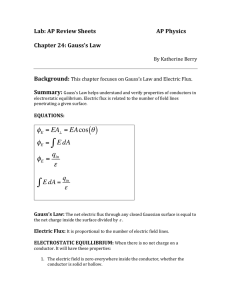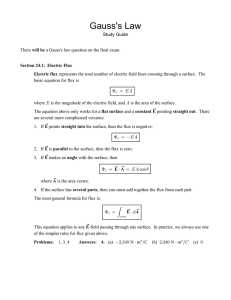Phys102 General Physics II Chapter 24: Gauss`s Law
advertisement
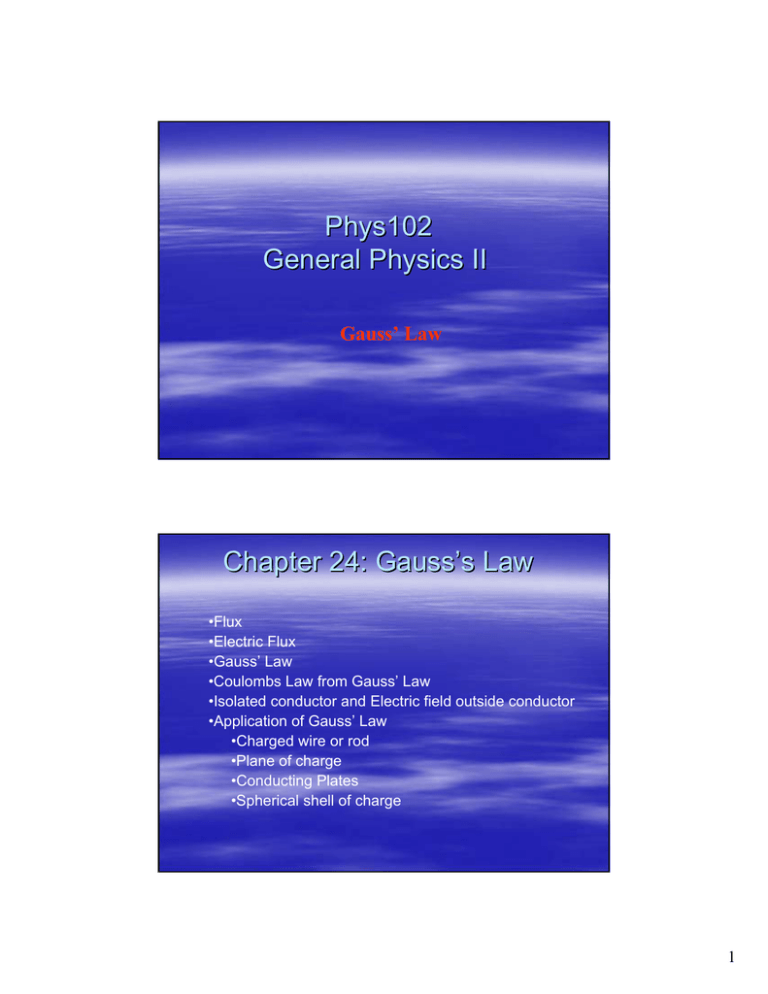
Phys102 General Physics II Gauss’ Law Chapter 24: Gauss’s Law •Flux •Electric Flux •Gauss’ Law •Coulombs Law from Gauss’ Law •Isolated conductor and Electric field outside conductor •Application of Gauss’ Law •Charged wire or rod •Plane of charge •Conducting Plates •Spherical shell of charge 1 Flux Φ = (normal component) x Area θ =0 Φ = vA Φ = v cosθ A Φ = v. A A = Anˆ θ = 45 Φ = 0.707vA Gauss’s Law Gauss’s law makes it possible to find the electric field easily in highly symmetric situations. Drawing electric field lines around charges leads us to Gauss’ Law The idea is to draw a closed surface like a balloon around any charge distribution, then some field line will exit through the surface and some will enter or renter. If we count those that leave as positive and those that enter as negative, then the net number leaving will give a measure of the net positive charge inside. 2 Flux of Electric Field lines The flux φ through a plane surface of area A due to a uniform field E is a simple product: n̂ Α φ = E A where E is normal to the area A . • φ = En A = 0 x A = 0 because the normal component of E is 0 E E n̂ Α E n̂ • φ = En A =E cos Q A θ Α Approximate Flux Φ = ∑ E • ∆A Exact Flux Φ= ∫ E • dA dA = nˆdA Circle means you integrate over a closed surface. 3 Find the electric flux through a cylindrical surface in a uniform electric field E ∫ E • dA = ∫ E cosθdA Φ = ∫ E cos180dA = − ∫ EdA = −EπR Φ = ∫ E cos90dA = 0 Φ = ∫ E cos180dA = ∫ EdA = EπR dA = nˆ dA Φ= a. b. c. 2 2 Flux from a. + b. + c. = 0 What is the flux if the cylinder were vertical ? Flux of Electric Field lines and Derivation of Gauss’ Law using Coulombs law Consider a sphere drawn around a positive point charge. Evaluate the net flux through the closed surface. Net Flux = Φ= ∫ E • dA = ∫ E cosθdA = ∫ EdA E II n Cos 0 = 1 For a Point charge E=kq/r2 Φ= ∫ EdA = ∫ kq /r dA 2 nˆ Φ = kq /r 2 ∫ dA = kq /r 2 (4 πr 2 ) dA Φ = 4 πkq 4 πk = 1/ε0 where ε0 = 8.85x10−12 Φ net = qenc ε0 C2 Nm 2 dA = nˆdA Gauss’ Law 4 Gauss’ Law Φ net = qenc ε0 ε 0 ∫ E.dA = qenc This result can be extended to any shape surface with any number of point charges inside and outside the surface as long as we evaluate the net flux through it. Gauss’ Law Φ net = qenc ε0 ε 0 ∫ E.dA = qenc This result can be extended to any shape surface with any number of point charges inside and outside the surface as long as we evaluate the net flux through it. 5 Gauss’ Law Φ net = qenc ε0 ε 0 ∫ E.dA = qenc This result can be extended to any shape surface with any number of point charges inside and outside the surface as long as we evaluate the net flux through it. Applications of Gauss’s Law Find electric filed of an infinite long uniformly charged wire of of negligible radius. Find electric field of a large thin flat plane or sheet of charge charge Find electric field around two parallel flat planes Find E inside and outside of a long solid cylinder of charge density ρ and radius r. Find E for a thin cylindrical shell of surface charge density σ Find E inside and outside a solid charged sphere of charge density ρ 6 Wire: Cylindrical symmetry Spherical symmetry 7 Electric field in and around conductors Inside a conductor in electrostatic equilibrium the electric field is zero ( averaged over many atomic volumes). The electrons in a conductor move around so that they cancel out any electric field inside the conductor resulting from free charges anywhere including outside the conductor. This results in a net force of F = eE = 0 inside the conductor. Electric field in and around conductors Any net electric charge resides on the surface of the conductor within a few angstroms (10-10 m). Draw a gaussian surface just inside the conductor. We know E=0 everywhere on this surface. Hence , the net flux is zero. Hence, the net charge inside is zero. 8 Electric field in and around conductors The electric field just outside a conductor has magnitude σ /ε0 and is directed perpendicular to the surface. – Draw a small pill box that extends into the conductor. Since there is no field inside, all the flux comes out through the top. – EA=q/ε EA=q/ε0= σA/ ε0, – so E= σ / ε0 9 Nonconducting sheet Two conducting plates 10 Two Nonconducting sheets 11
